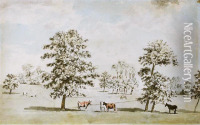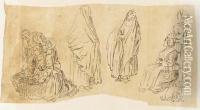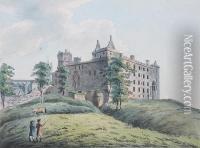Francis, Captain Grose Paintings
Francis Grose was a British antiquary, draughtsman, and lexicographer, who was born in 1731 and died in 1791. He is best known for his antiquarian works, particularly his series of books that documented the medieval architecture and ancient buildings of England, Scotland, and Ireland. Grose's work was influential in the Gothic Revival movement in architecture and played an important role in the preservation of British heritage.
Grose was born into a well-off family; his father was a Swiss immigrant and jeweller. However, he did not initially set out to become an antiquary. He first pursued a military career and became a captain in the Surrey militia, which earned him the lifelong title of 'Captain' Grose. His military career was rather uneventful and he eventually devoted himself to his antiquarian interests.
His major works include 'The Antiquities of England and Wales' (first published in 1772), which was a series of volumes that provided an exhaustive survey of the ancient and historical monuments found throughout the countries. This was followed by similar works on Scotland ('The Antiquities of Scotland', 1789) and Ireland ('The Antiquities of Ireland', published posthumously in 1791). These books were highly popular and were among the first to present such detailed information to a general audience, rather than just to scholars.
Grose was also interested in the contemporary culture of the British lower classes. His 'A Classical Dictionary of the Vulgar Tongue' (1785) was a compilation of the slang used by the common people, thieves, and other groups in London and is still referenced by historians today for its insights into 18th-century vernacular speech.
Despite his important contributions to antiquarian studies, Grose's personal life was marked by financial difficulties, largely due to his generous nature and somewhat disorganized lifestyle. He died suddenly in Dublin in 1791 while working on the second volume of 'The Antiquities of Ireland'. His legacy is that of a pioneering figure in the preservation and documentation of British heritage, and his works remain valuable resources for historians, archaeologists, and architects.



